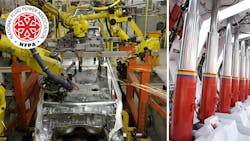The trend toward the “electrification” of cars and trucks, replacing their gas-powered engines with batteries or fuel cells, continues to grow. It now includes mobile equipment and off-highway construction vehicles. What will that mean to the fluid power industry and all of the hydraulic systems and components it supplies to OEMs making off-highway vehicles and equipment?
Marty Christianson, the market manager for E-Mobility and AE Cooling Systems at Hydac Corp., will address that question in a presentation, “Electronification of Mobile Equipment – Impact and Opportunities on the Fluid Power Industry,” at the National Fluid Power Association’s Dec. 2 Conference.
“This is an ongoing question that needs to be addressed,” says Christianson. “The electricity currently comes from where it always has come from, primarily fossil fuel-powered plants. As the demand for electricity increases due to EVs, the challenge will be finding new and cleaner ways of generating electricity. For the construction industry, there’s also the issue of how electricity will be delivered to remote, off-highway sites.”
The presentation will address battery and fuel cells and the infrastructure needed for each. It will also look at how removing the gas engine will affect the hydraulic circuitry when the internal combustion engine and its limitations are removed. There will likely be a major focus on technologies that promote hydraulic efficiency, productivity and weight reduction. These include:
- More efficient valves.
- Filters for hydraulic fluids.
- Cooling for batteries, fuel cells and hydraulic fluid.
- Hydraulic power units to power work functions, steering and braking.
- Accumulator that store energy and increase vehicle efficiency.
“One of the benefits of construction and mobile equipment going electric is that there will be less noise pollution at worksites,” says Christianson. “This not only addresses safety concerns, but also allows for silent operation around the clock in residential areas where excess noise is undesirable.
“It will also challenge engineers to design highly efficient vehicles and equipment,” he continues. “Electric motors are almost 95% efficient in most cases, and this will let engineers focus their efforts on downstream vehicle functions and open the door for more ‘out of the box’ thinking than what was previously possible.”
The key to successfully transitioning to electric vehicles will be a major change in battery technology, he says. “A gas-powered engine can run 24 hours a day and only require a few minutes of down-time to refuel,” says Christianson. “With batteries and hydrogen fuel cells, the time for recharging may be longer.”
“The downside of electrification is that it could double the cost of vehicles and mobile equipment, especially if volumes are relatively small,” he notes. “And mining the metals needed for battery construction does not come without a large and somewhat different carbon footprint than obtaining fossil fuels.”
“My NFPA presentation is targeted at the program/vehicle engineers, encouraging them to evaluate where they are in the electrification process. Then they can ascertain where and what types of products will be most beneficial,” says Christianson. “They should recognize that this technology is coming, and they need to get on board with it as the years progress. More importantly, however, I want them to come away with information, thoughts, and ideas they can apply in their own careers.”
To learn more about the conference and register for it, visit this site.
About the Author
Stephen Mraz
Steve serves as Senior Editor of Machine Design. He has 23 years of service and has a B.S. Biomedical Engineering from Steve was a Flight officer in the U.S. Navy. He is currently responsible for areas such as aerospace and medical.

Leaders relevant to this article:

